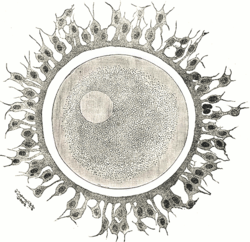Zona pellucida
| Zona pellucida | |
|---|---|

Human ovum: The zona pellucida is seen as a thick clear girdle surrounded by the cells of the corona radiata.
|
|
| Identifiers | |
| MeSH | A05.360.490.690.950 |
| Dorlands /Elsevier |
z_01/12869767 |
| FMA | 18674 |
|
Anatomical terminology
[]
|
|
The zona pellucida (plural zonae pellucidae, also egg coat or pellucid zone) is a glycoprotein layer surrounding the plasma membrane of mammalian oocytes. It is a vital constitutive part of the oocyte. The zona pellucida first appears in unilaminar primary oocytes. It is secreted by both the oocyte and the follicular cells. The zona pellucida is surrounded by the cumulus oophorus. The cumulus is composed of cells that care for the egg when it is emitted from the ovary.
This structure binds spermatozoa, and is required to initiate the acrosome reaction. In the mouse (the best characterised mammalian system), the zona glycoprotein, ZP3, is responsible for sperm binding, adhering to proteins on the sperm plasma membrane (GalT). ZP3 is then involved in the induction of the acrosome reaction, whereby a spermatozoon releases the contents of the acrosomal vesicle. The exact characterisation of what occurs in other species has become more complicated as further zona proteins have been identified.
In humans, five days after the fertilization, the performs zona hatching; the zona pellucida degenerates and decomposes, to be replaced by the underlying layer of trophoblastic cells.
The zona pellucida is essential for oocyte death and fertilization.
In some older texts, it has also been called zona striata and stratum lucidum (not to be confused with the stratum lucidum of the skin).
Glycoproteins in ZP1, 2, 3 and 4 are targets for immunocontraception in mammals.
In non-mammalian animals, the zona pellucida (called vitelline layer) plays an important role in preventing cross-breeding of different species, especially in species that fertilize outside of the body (e.g. fish).
...
Wikipedia
